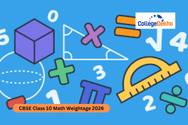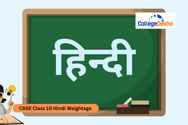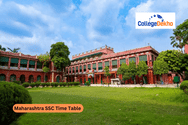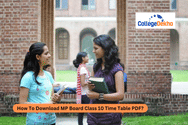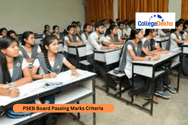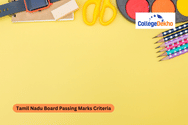RBSE 10th Syllabus 2025-26 has been released by the Rajasthan Board on its official website at rajeduboard.rajasthan.gov.in. In the article below, all the information related to the RBSE syllabus has been provided.


Never Miss an Exam Update
About RBSE 10th Syllabus 2025-26
RBSE 10th Syllabus for 2025-26 for English, Mathematics, Science, Social Science are provided here in detail. You can check the syllabus for all subjects of Class 10th and prepare accordingly. To make it convenient for you, the syllabus PDFs are also provided. Download the syllabus PDF and check the detailed syllabus for all subjects. While preparing for the exams, ensure that all the chapters are completed before the exams. In addition, you can also RBSE 10th Exam Pattern 2025-26 to know the types of questions appearing in the exam. After completing the syllabus, you can solve the previous year question papers and test your knowledge. For more details about the RBSE 10th Syllabus for 2025-26, continue reading the article.
RBSE 10th Syllabus Download PDF 2025-26
The RBSE board has just released the curriculum for Class 10, and the great news is that it’s the same as last year’s! You can check out the updated syllabus on the official website. If there are any changes, the board will keep you in the loop, so no worries there! Since the exam question paper will be based on this syllabus, it’s super important for you to study every chapter and topic included. You can easily access the RBSE 10th 2025-26 syllabus in PDF format below.
RBSE 10th Subject-Wise Syllabus 2025-26
Students, make sure to use the RBSE Class 10 Syllabus 2025-26 as a helpful guide to organize your studies and prepare for the upcoming board exams! This syllabus is a great tool to keep you on track. Remember, the RBSE Class 10 exam includes a mix of multiple-choice questions (MCQs), short answer questions, and long answer types, all covering every chapter and topic in the syllabus. So, dive in and get ready to shine in your exams! Students can also refer to RBSE class 10 previous years question papers to review the topic allocation from the syllabus. A detailed RBSE 10th 2025-26 syllabus is provided below.
RBSE 10th English Syllabus 2025-26
Students can refer to the detailed information about the RBSE Class 10 English Syllabus 2025-26 from the pointers given below and use it to efficiently prepare for the exam:
Reading (15 Marks)
- Two unseen passages of a total of 350 words with a variety of questions including 4 marks for vocabulary.
- Only prose passages will be used. One will be factual and the other will be discursive.
- Passage 1—150 words (8 Marks), Eight Multiple Choice Questions including 2 questions on vocabulary—one testing the knowledge of similar word and the other testing the knowledge of opposite word.
- (ii) Passage 2—250 words (8 Marks), Eight Very Short Answer Type Questions including 2 questions on vocabulary—one testing the knowledge of similar word and the other of opposite word.
Writing (13 Marks)
- Letter Writing — One out of two (Word Limit 80)
- (a) Personal — To friends, relatives, and members of the family.
- (b) Official — To Govt. officials, The Editor of a newspaper or a magazine, the Headmaster/Principal
- (c) Email — To family, friends, relatives, Govt. officials, the editor, teachers, headmaster, principal, and so on.
- (ii) To write a short story on a given outline in 100 words.
- (iii) A short writing task based on a verbal or a visual stimulus (picture chart, table, etc.) with internal choice in about 60 words.
Grammar (15)
6 Fill in the blanks type questions and 4 very short answer type questions involving the use of particular structures within a context.The Grammar syllabus will include the following areas for teaching—
1. Tenses
2. Subject-Verb Concord
3. Clauses (Complex Sentences)
4. Active and Passive Voice
5. Reported Speech
First Flight—Prose
(a) One out of two extracts from different prose lessons included in the textbook. Approximately 150 words each with the following type of questions— Six questions in each passage : 4 Multiple Choice Questions and 2 Very Short Answer Type Questions testing comprehensive ability.
(b) Three Short Answer Type Questions (out of four, around 20-30 words each) excluding Drama Text.
(c) One out of two Long Answer Type Questions extrapolative in nature based on any one of the prose lessons excluding Drama Text from the textbook to be answered in about 60 words.
(d) One out of two Long Answer Type Questions on Drama Text (local and global comprehension question) in about 60 words.
(ii) First Flight—Poetry
(a) One out of two extracts from the poems prescribed to test comprehension and appreciation with 1 Multiple Choice Question and 2 Short Answer Type Questions. (b) Two out of three Short Answer Type Questions on interpretations of themes and ideas contained in the poems to be answered in about 20–30 words each.
(c) One out of two Long Answer Type Questions on interpretations of themes and ideas contained in the poems to be answered in about 60 words.
(iii) Footprints without Feet—Supplementary Reader
(a) One out of two Long Answer Type Questions from Supplementary Reader to interpret, evaluate and analyse characters, plot or situations occurring in the lessons to be answered in about 60 words.
(b) Two out of three Short Answer Type Questions on interpreting and evaluating nature based on lessons to be answered in 20–30 words each.
(c) Five Multiple Choice Questions testing factual aspects of the lessons.
RBSE 10th Mathematics Syllabus 2025-26
Mathematics includes a lot of important units and chapters. The theory paper in Mathematics will be conducted for 80 marks. Students can check the detailed RBSE Class 10 Math Syllabus 2025-26 from the table given below:
Unit | Unit and Chapter Names | Topics |
|---|---|---|
1 | NUMBER SYSTEMS 1. Real Numbers | The Fundamental Theorem of Arithmetic, Revisiting Irrational Numbers. |
2 | ALGEBRA 2. Polynomials 3. Pair of Linear Equations in Two Variables 4. Quadratic Equations 5. Arithmetic Progressions | Geometrical Meaning of the Zeroes of a Polynomial, Relationship between Zeroes and Coefficients of a Polynomial. Algebraic Methods of Solving a Pair of Linear Equations (i) Substitution Method (ii) Elimination Method. Quadratic Equations, Solution of a Quadratic Equation by Factorisation, Nature of Roots. |
3 | GEOMETRY 6. Triangles 7. Circles | Similar Figures, Similarity of Triangles, Criteria for Similarity of Triangles. |
4 | COORDINATE GEOMETRY 8. Coordinate Geometry | Distance Formula, Section Formula. |
5 | TRIGONOMETRY 9. Introduction to Trigonometry 10. Some Applications of Trigonometry | Trigonometric Ratios, Trigonometric Ratios of Some Specific Angles, Trigonometric Identities. Heights and Distances. |
6 | MENSURATION 11. Areas Related to Circles 12. Surface Areas and Volumes | Areas of Sector and Segment of a Circle, Surface Area of a Combination of Solids, Volume of a Combination of Solids. |
7 | STATISTICS & PROBABILITY 13. Statistics 14. Probability | Mean of Grouped Data, Mode of Grouped Data Median of Grouped Data. |
RBSE 10th Social Science Syllabus 2025-26
Students can check the information about the RBSE Class 10 Social Science Syllabus 2025-26 from the table given below:
Unit | Chapters |
|---|---|
Unit - 1: The Rise of Nationalism in Europe (Part A) | (i) The French Revolution and the Idea of the Nation (ii) The Making of Nationalism in Europe (iii) The Age of Revolutions: 1830-1848 (iv) The Making of Germany and Italy (v) Visualizing the Nation (vi) Nationalism and Imperialism |
Unit - 1: Nationalism in India (Part B) | (i) The First World War, Khilafat and Non-Cooperation (ii) Differing Strands within the Movement (iii) Towards Civil Disobedience (iv) The Sense of Collective Belonging |
Unit - 2: The Making of a Global World (Part A) | The Pre-modern world – Silk Routes Link the World, Food Travels: Spaghetti and Potato, Conquest, Disease and Trade, The Nineteenth Century (1815-1914) – A World Economy Takes Shape, Role of Technology, Late nineteenth-century Colonialism, Rinderpest,or the Cattle Plague,Indentured Labour Migration From India, Indian Entrepreneurs Abroad, Indian Trade, Colonialism and the Global System, The Inter-war Economy – Wartime Transformations, Post-war Recovery, Rise of Mass Production and Consumption, The Great Depression,India and the Great Depression, Rebuilding a World Economy: The Post-War Era – Post- war Settlement and the bretton Woods Institutions, The Early post-war Years, Decolonisation and Independence, End of Bretton Woods and the Beginning of Globalisation. |
Unit - 2: The Age of Industrialization (Part B) | Before the Industrial Revolution – The Coming Up of the Factory, The Pace of Industrial Change,Hand Labour and Steam Power – Life of the Workers, Industrialisation in the colonies - The Age of Indian Textiles, The condition of the weavers, Manchester Comes to India, Factories Come Up – The Early Entrepreneurs, Arrival of workesrs from different places, The Peculiarities of Industrial Growth – Small-scale Industries Predominate, Market for Goods. |
Unit - 3: Print Culture and the Modern World | The First Printed Books – Print in Japan, Print Comes to Europe – Gutenberg and the Printing Press, The Print Revolution and its Impact – A New Reading Public, Religious Debates and the Fear of Print, Print and Dissent, The Reading Mania – Tremble, therefore, tyrants of the world, Print Culture and the French Revolution, The Nineteenth Century – Children, Women and Workers, Further Innovations, India and the World of Print – Manuscripts Before the Age of Print, Print Comes to India, Religious Reform and Public Debates, New Forms of Publication – Women and Print, Print and the Poor People, Print and Censorship. |
| Geography | |
Unit - 1: RESOURCES AND DEVELOPMENT | Classification of Resources, Development of Resources, Resources Planning in India, Land Resources, Land Utilisation, Land use pattern in India, Land degradation and conservation measures, Soil as a resource, Classification of Soils, Soils Erosion and Soil Conservation. |
Unit - 2: FOREST AND WILDLIFE RESOUCES | Flora and Fauna in India, Conservation of forest and Wildlife in India, Types and Distribution of forest and wildlife Resources, Community and Conservation |
Unit - 3: WATER RESOUCES | Water Scarcity and the need of water conservation and management, Multi-Purpos, River Project and Integrated water resources management, Rain water Harvesting. |
Unit - 4: AGRICULTURE | Types of Farming – Primitive subsistence Farming, Intensive subsistence Farming, Commercial Farming, Cropping Pattern, Major Crops- Rice, Wheat, Millets- Bajra, Maize, Pulses, Food Crops other than Grains, Horticultur, Non- Food Crops, Fibre Crops, Technological and Institutional Reforms. |
Unit - 5: MINERALS AND ENERGY RESOUCES | Meaning of Minerals, Mode of Occurrence of Minerals, Ferrous and non-ferrous Minerals, NonMetallic minerals, Rock minerals, Conservation of Minerals Energy Resources-conventional And non-conventional sources, conservation of energy recourses |
Unit - 6: MANIFACTURING INSDUTRIES | Importance of Manufacturing, Classification of Industries, Industrial Pollution and invironmental Degradation, Control of Environmental Degradation |
Unit - 7: LIFELINE OF NATIONAL ECONOMY | Transport: Roadways, Railways, Pipelines, Waterways and Major Sea Ports, Airways, Communication, International trade, Tourism-as a trade. |
| Political Science | |
Unit - 1: POWER SHARING | Belgium and Sri lanka, Majoritarianism in Sri Lanka Accommodation in Belgium, Need of Power Sharing, Forms of power-sharing |
Unit - 2: FEDERALISM | Federalism, Federal System in India, Working Procedure of the Federalism, Linguistic States, Language Policy, Centre-State Reactions, Decentralization In India. |
Unit - 3: GENDER, RELIGION AND CASTE | Gender and Politics- Feminist movements, Woman Political Representation, Religion, Communalism and Politics Caste and Politics, Social and Religious Diversity of India, Caste Inequality |
Unit - 4: POLITICAL PARTIES | Importance of Political Parties,Function of Political Parties, Type of political parties, Popular Participation in Political Parties, National Parties, Dimensions of change in Parties. |
Unit - 5: OUTCOMES OF DEMOCRACY | Evaluation of the results of democracy, Accountable, Responsive and Legitimate Government, Economic growth and development, Economic outcomes of democracy, reduction of inequality and poverty, Accommodation of social diversity, Dignity and freedom of the citizens. |
| Economics | |
Unit - 1: DEVELOPMENT | Development Promises-Different People, Different goals, Income and other Goals, National Development, Comparison of different countries and states, Income and other criteria, Public facilities, Human Development Report, sustainability of Development. |
Unit - 2: SECTORS OF THE INDIAN ECONOMY | Sectors of Economic activities, Comparing the three sectors- Counting the various goods and services, Historical Change in Sectors, Primary, Secondary and Tertiary in India, Create More Employment- MGNREGA 2005, Divisions of sectors as organised and unorganised, Sectors in term of ownership: Public and Private Sectors. |
| Unit 3: MONEY AND CREDIT | Money as medium of exchange, Modern forms of money- Currency, Depostis with banks, Loan activities of Banks, Two different credit situations, Terms of Credit, Formal Sector credit in India, Comparative study of formal and informal Credit, Self help groups for the Poor. |
| Unit 4: GLOBLISATION AND THE INDIAN ECONOMY | Production across countries, Interlinking production across countries, Foreign trade and integration of markets, Meaning of Globalisation - Factors that have enabled Globalisation, Liberlisatian of foreigm trade and foreign investment policy, World Trade Organization, Impact of Globalisation in India, The Struggle for a fair Globalisation. |
| Unit 5: CONSUMER RIGHTS | The consumer in the market place, Consumer movement, Consumer Rights-Right to Safty, Right to Information,Right to Choose, Right to Seek redressal, Learning to become well informed consumers, Efforts to take the Consumer Movement Forward. |
RBSE 10th Science Syllabus 2025-26
Science is also one of the most important subjects for the class 10 students. Check out the detailed information about the
RBSE Class 10 Science Syllabus 2025-26
from the table given below:
Unit | Chapters |
|---|---|
Unit I: CHEMICAL SUBSTANCES - NATURE AND BEHAVIOUR | Chemical equation-Writing a Chemical equation, Importance of balanced chemical equation, Types of chemical reactions- Combination Reaction, Decomposition Reaction, Extotharmi Reaction, Endotharmic Reaction, Deisplacement Reaction, Double Displacement Reaction, Oxidation and Reducation, Effects of oxidation reactions in everyday life- Corrosion , Rancidity. |
Unit II: ACIDS, BASES AND SALTS | Chemical properties and reactions of acids and bases, Similarities in acids and bases- Acid or base in water solution, Strength of an acid or base solution- Importance of PH in every day life, More about salts- Family of Salt, PH of salts, Chemicals from Common Salt, Dryness of salt crystals. |
Unit III: METALS AND NON METALS | Physical and chemical properties of metals and non-metals and chemical Reaction - Combustion in air, with water, with acid, with metals salt solutions, The reactivity series ,Formation and properties of iconic compound, Occurrence of metal - Extraction of metals, Enrichment of ore, Extraction metals on the basis of Reactivity series, Refining of metals, Corrosion- Prevention of corrosion. |
Unit IV: CARBON AND ITS COMPOUNDS | Bonding in carbon compounds- Formation of covalent bond, Versatile nature of carbon- Saturated and Unsaturated carbon compound, Chains, Branches and rings, Homologus series, Nomenclature of carbon compound, Chemical properties of carbon compounds- Comtustion, oxidation , Additon reaction, Substitution reaction, Some important carbon compounds- ethanol and ethanoic acid, soaps and detergents. |
Unit V: LIFE PROCESSES | Life processes, Nutrition- Autotrophic Nutrition, Heterotrophic Nutrition , Nutrition in Organisms, Nutrition in Human Beings, Respiration, Transportation- Human Beings,Plants , Excretion- Human Bings , Plants. |
Unit VI: CONTROL AND COORDINATION | Animals Nervous system - Reflex action, Human Brain, Tissue Protection, Nervous tissue action, Coordination in plants- Immediate Response to Stimulus, Movement Due to Growth, Hormones in animals. |
Unit VII: REPRODUCTION IN ORGANISMS | Create exact copies of themselves by Organisms- The Importance of Variation, Modes of reproduction used by single Organisms- Fission, Fragmentation, Regenration, Budding, Vegetative Propagation, Spore Formaton, Sexual reproduction- Need for Sexual mode of Reproduction, Sexual reproduction in flowering plants, sexual reproduction in Human Bings, Male Reproductive system, Female Reproductive system, No fertilization of the egg, Reproductive health. |
Unit VIII: HEREDITY | Accumulation of variation during reproduction, Heredity- Inherited Traits, Rules for the inheritance of Traits-Mendel's Contribution, Expression of Inharited Traits, Sex Determination |
Unit IX: LIGHT& REFLECTION AND REFRACTION | Reflection of light, Spherical mirrors- Image formation, Representation of Image Formed by Spherical mirrors Using Ray Diagrams, Sign Convention for Reflection, Mirror Formula and Magnification Refraction of light -Refraction through a Rectangular Glass Slab, The Refractive Index , Refraction by Spherical lenses , Image Formation by Lenses, Image formation in Lenses Using Ray Diagrams, Sign Convention for Spherical Lenses , Lens Formula and Magnification, Power of Lens. |
Unit X: THE HUMAN EYE AND THE COLOURFUL WORLD | The Human Eye- Power of Accommodation, Defects of vision and their correction, Refraction of light through a prism, Dispersion of white light by a glass prism, Atmospheric refraction, Scattering of lightTyndall Effect, Clear Blue Sky. |
Unit XI: ELECTRICITY | Electric current and circuit. Electric potential and potential difference, Circuit diagram, Ohm’s law, factors on which the resistance of a conductor depends, Resistance of a System of Resistors- Series Parallel , Heating effect of electric current - Practical Application of Heating effect of electric current, Electric power. |
Unit XII: MAGNETIC EFFECTS OF ELECTRIC CURRENT | Magnetic field and field lines, Magnetic field due to current carrying conductor- Magnetic Field due to a current through a straight conductor, Right hand thumb rule, Magnetic field due to a current through a circular loop, Magnetic field due to a current in a solenoid, Force on current carrying conductor in a Magnetic field- Fleming's left hand rule, Domestic electric circuits. |
Unit XIII: OUR ENVIRONMENT | Eco-system - Food Chains and webs, Environmental Problems-Ozone layer and Depletion, Garbage Management, Biodegradable Substances, Non Biodegradable Substances. |
RBSE 10th Information Technology Syllabus
Important units like Advanced Processing Tools, Cyber Crime & E-commerce, etc. are included in the RBSE class 10 syllabus 2025-26 for information technology. The information technology syllabus for RBSE 10th 2025-26 is provided in the table below:| Units | Topics | Theory Marks | Practical Marks |
| Advance Processing tools | Introduction to MS Excel | 10 | 0 |
| Comparison between MS Word and MS Excel | |||
| Worksheets and Workbooks: Creating a Workbook | |||
| Opening, Labeling, and Formatting Workbook Tabs | |||
| Insert and Delete Cells, Rows, and Columns | |||
| Merging, Splitting, Hiding/Unhiding Columns and Rows | |||
| Reposition Sheets | |||
| Naming, Adding, Deleting, Hiding, Unhiding, Saving Workbooks and Worksheets | |||
| Navigating MS Excel | |||
| Format, Filter, and Sorting of Cells | |||
| Headers and Footers | |||
| Set Margins For Headers and Footers | |||
| Information About Printing: Select Print Area, Print a Range of Pages | |||
| About Entering Information into Excel: Entering Data, and others | |||
| Cybercrime and E-commerce | Cyber Law | 25 | 15 |
| Technical Aspects of Cyber Crime | |||
| Computer Viruses | |||
| Social Engineering | |||
| Phishing | |||
| Software Piracy | |||
| Intellectual Property | |||
| Mail Bombs | |||
| E-Commerce: Features, Advantages to Organizations, Customers, and Society | |||
| Technical and NonTechnical Disadvantages | |||
| E-Commerce Business Models | |||
| The six components of a marketing plan for small business | |||
| Perform SWOT Analysis | |||
| Business Philosophy and Vision | |||
| E-Business Security | |||
| Application and its system software | Definition of Computer Data | 25 | 15 |
| Information | |||
| Computer Instruction | |||
| Computer Program | |||
| Software: Application and System Software | |||
| Uses and Examples of Application Software and System Software | |||
| Proprietary Software and Open Source Software (OSS) | |||
| Foundation of the Open Source Software | |||
| Comparison Between OSS and Proprietary Software | |||
| Internet and its application | Objectives of Computer Network Application of Networks, Local Area, others | 10 | 0 |
| Components of Computer Network | |||
| Advantages and Disadvantages of Computer Network | |||
| Application of Networks: Local Area, and others |
How to Download RBSE 10th Syllabus 2025-26?
Every year, the RBSE board publishes the curriculum and syllabus for class 10 on the official website. Students can follow these steps to download the RBSE class 10th 2025-26 syllabus from the official website below:
- Step 1: Go to the Rajasthan Board's official website.
- Step 2: Select the link labeled "Anudeshika Pathyakram 2025-26."
- Step 3: Select "Kaksha 10 Hetu" from the menu.
- Step 4: The RBSE 10th syllabus will be displayed on the screen.
- Step 5: Download and save the class 10 syllabus RBSE 2025-26 PDF for future reference.
Are you feeling lost and unsure about what career path to take after completing 12th standard?
Say goodbye to confusion and hello to a bright future!

FAQs
Students can buy NCERT or refer to the books prescribed by their teachers to check the RBSE 10th Syllabus 2025-26 since these are published based on the latest syllabus.
Rajasthan Board of Secondary Education has released the RBSE 10th Syllabus 2025-26 on the official website to be downloaded by the students. No major changes are reflected in the syllabus however still the students need to download the latest syllabus to prepare for the exam.
Students need to first visit the official website of the Rajasthan Board of Secondary Education at rajeduboard.rajasthan.gov.in/ and now click on the option called अनुदेशिका 2020 एवं पाठयक्रम 2025-26 from the left-hand side of the homepage to download the RBSE 10th Syllabus 2025-26.
Rajasthan Board of Secondary Education provides the PDF of the RBSE 10th Syllabus 2025-26 in both English and Hindi to be downloaded by the students from the official website.
Old books and curriculum can be used to prepare the RBSE 10th Syllabus 2025-26. No major changes are reflected in the curriculum so the old books can be used by the students without any problem however do check the latest curriculum just to make sure.
Was this article helpful?









